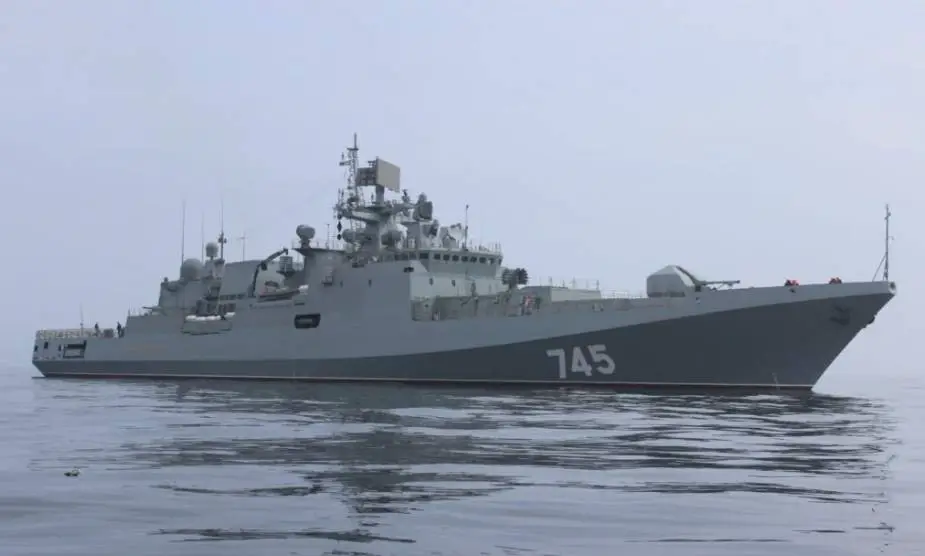Since 2000, Russia’s naval export deliveries have exceeded 70 main platforms, according to the Rosoboronexport (a subsidiary of state corporation Rostec) arms exporting company.
Follow Navy Recognition on Google News at this link

Admiral Grigorovich (Project 11356) frigate at Yantar Shipyard (Picture source: Russian Navy)
Speaking to the TASS news agency on November 16, a spokesperson for Rosoboronexport said the entity had exported naval weapon systems worth some USD28 billion since the early 2000s. “Since late 2000, some 70 surface ships and submarines have been delivered to the foreign customers,” he said.
In recent years, Russia’s shipbuilding industry has placed an emphasis on the development of its portfolio of frigates, various boats, mobile coastal defense missile (MCDM) systems, and naval weapons. Regarding frigates, it is the Project 11356 (Admiral Grigorovich-class) stealth surface combatant that is among the largest Russian-designed export-oriented naval platforms. India is the largest foreign operator of Project 11356 — the Indian Navy (IN) now sails six frigates of the class. Under an agreement signed between Russia and India in late November 2018, the IN is set to receive four more Project 11356 frigates, of which two will be built in Russia and the remaining two — at the production capacities of the Goa Shipyard Limited (GSL) company. In late September 2020, GSL laid the keel of the first licensed Project 11356 ship. According to the executives of the shipyard, the surface combatants will be delivered to the military service within several years after the keel laying ceremonies.
The Project 11356 has a full displacement of 4,035 t and produces a top speed of 30 kt and a cruise range of 4,859 nm. The ship is armed with a Club-N missile system with eight ready-use missiles, a Shtil-1 surface-to-air missile system with 24 ready-use missiles, an A-190E-01 100 mm naval gun, two AK-630M 30 mm close-in weapon systems, a Paket-E/NK anti-torpedo/anti-submarine warfare unit, and a Fregat-M2EM 3D radar with a target detection range of some 300 km.
Rather unexpectedly, Russia is holding its position on the market of small boats that are intended for landing of relatively small groups (up to 20-30 persons), tactical fire support, and reconnaissance and patrol missions. In this segment, the country’s industry is represented by the BK (BK-9, BK-10DE, BK-10, BK-10M, and BK-16E) series of boats and Project 21980E (Grachonok-class) counter-sabotage boats by the Rybinsk Shipyard (a subsidiary of Rostec’s Kalashnikov Group) and the Project 03160E (Raptor-class) patrol boats by JSC Pella Shipyard. In early April 2020, Rosoboronexport’s Director General Alexander Mikheev announced a contract for delivery of some BK-10 high-speed assault craft to a Sub-Saharan African country.
It should be mentioned that the Russian defense industry focuses on the development of new MCDM systems that can be integrated with a single anti-access/area denial concept. At present, a tandem comprising the Bastion and the Bal MCDMSs has been put into force; however, new shore-based anti-ship weapons are now being developed. At the International Maritime Defence Show 2019 (IMDS 2019), the Rubezh-ME MCDMS broke its cover. Compared with the Bal and Bastion, the Rubezh-ME is a less expensive system with an improved cost-effectiveness ratio. Each Rubezh-ME combat vehicle is armed with four ready-use Kh-35UE anti-ship missiles.
Rosoboronexport has also entered the market of reinforced fiberglass (RFG) mine countermeasures vessels, with the Project 12701E Alexandrite-E-class RFG MCM platform being the latest ship of the type.
© Copyright 2020 TASS Navy Recognition. All rights reserved. This material may not be published, broadcast, rewritten or redistributed.



